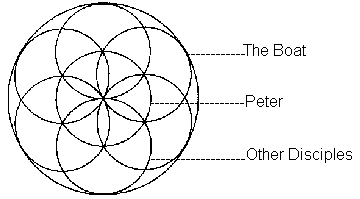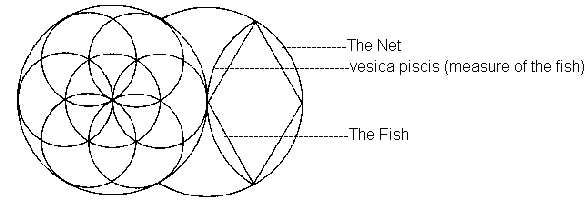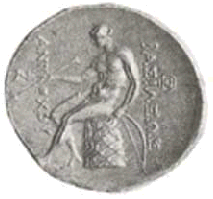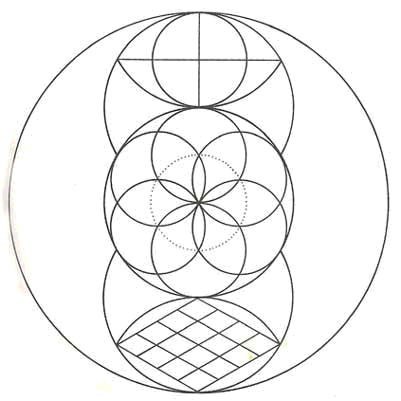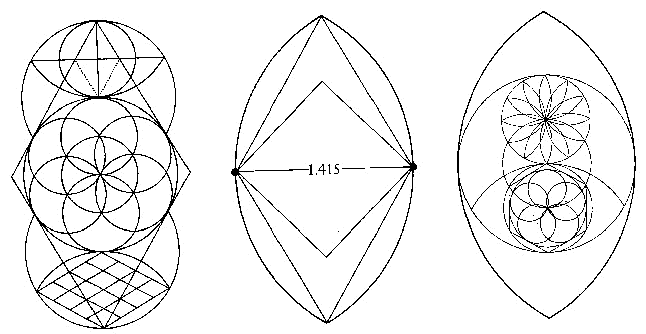The Great Pyramid and the 153 Fish in the Net
According to John, Jesus performed his first public miracle at a wedding feast in Cana, when he turned water into wine (John 2:1-11). Similarly, Pagan myth records Dionysus turning water into wine at his own wedding to Ariadne (Freke/Gandy, 38). Also in John, Jesus miraculously helped his disciples catch a large number of fish at the Sea of Galilee -- 153, to be precise (John 21 : 11). In the aretalogy written by Porphyry, the great mathematician Pythagoras also performed this supernatural feat. Further, the Pythagoreans regarded 153 as a sacred number due to its use in a mathematical ratio called "the measure of the fish," which produces the mystical symbol of the vesica pisces -- the intersection of two circles which yields a fish-like shape. This "sign of the fish" is, of course, still widely used today as a symbol of Christianity (Freke/Gandy, 39).
Pythagoras and his disciples established religious communities throughout the Greek world. All were strict vegetarians. Men and women were admitted equally, they took vows of celibacy and all possessions were held in common. Neophytes took a 5-year vow of silence. They rose before dawn and worshipped the rising sun as the "eye" of the Supreme Spiritual Lord who is the source of all energy and life. They spent the day in philosophical study and religious observances, then finished their day by reading scriptures at a communal (and meatless) evening meal. All wore white robes. Pythagoras himself wore both white robes and a golden coronet. He was reputed to have worked many miracles of healing, including reviving several dead people. He was said to be the son of a god, Apollo, and born of a mortal mother, who was called "Parthenesis", which means virgin.
Most scholars believe that he obtained most of his mystical knowledge in Egypt, but recent scholarship has traced his travels through India as well. There is supporting evidence for this in the Vedic literature of India which mentions him as a great empowered guru called Yavana Acharya, which means "Spiritual Master for the Meat Eaters" (Yavanas--as the Greeks were known to the ancient vegetarian residents of India). Like another great vegetarian miracle worker, Jesus Christ, Pythagoras is strangely associated with fish. Now scholars have compared two stories told about these two mystics and concluded that neither are about real fish, but compose an allegorical code to explain a deep mathematical and mystical relationship.
The Pythagoreans had a diagram of 2 intersecting circles, one above, one below, with the circumference of one touching the center of the other. The 2 circles represented the spiritual and the material domains. The "transcendental" region where the circles intersect resembles a fish shape-exactly as used as the symbol for Christianity. The Pythagoreans called this shape vesica piscis. The ratio of the height of this fish symbol to its length is 153 : 265, which is the nearest whole number to the square root of 3 and the controlling ratio of the equilateral triangle. OK, OK, you didn't really think you could learn about Pythagoras without plowing through some math, did you?
Anyway, remember that first number-153. Now the stories of both Pythagoras and Jesus have them telling fishermen-who have failed to catch any fish all day-to cast their nets again. Miraculously, their nets come in full of fish. Pythagoras was said to have correctly predicted the exact number of fish caught. In his story, the mystic number is not revealed, but in the Gospel story of Jesus the number of fish caught is given-exactly 153!
Also, in the story of Jesus' feeding the multitudes with "loaves and fishes", Christ is quoted as trying to explain to his disciples the importance of the numbers of loaves, fishes, baskets of leftovers, numbers of people fed, etc. The idea is that these stories are not about a fish eating at all but about mathematical relationships and mystical numbers that reveal, to the initiated, hidden truths about the relationship of the spiritual and material dimensions.
The Cheops Pyramid constructs can demonstrate this mystical number:
Cheop's pyramid height = 486.256 ft (Churchward 1910)
|
J. Iuliano
(Sent via e-mail September 13, 2001 )
![]()
Biblical Resources
From:
http://bibleontheweb.com/Bible.asp
Revised Standard Version
John 2:1-11 1 On the third day there was a marriage at Cana in Galilee, and the mother of Jesus was there; 2 Jesus also was invited to the marriage, with his disciples. 3 When the wine failed, the mother of Jesus said to him, "They have no wine." 4 And Jesus said to her, "O woman, what have you to do with me? My hour has not yet come." 5 His mother said to the servants, "Do whatever he tells you." 6 Now six stone jars were standing there, for the Jewish rites of purification, each holding twenty or thirty gallons. 7 Jesus said to them, "Fill the jars with water." And they filled them up to the brim. 8 He said to them, "Now draw some out, and take it to the steward of the feast." So they took it. 9 When the steward of the feast tasted the water now become wine, and did not know where it came from (though the servants who had drawn the water knew), the steward of the feast called the bridegroom 10 and said to him, "Every man serves the good wine first; and when men have drunk freely, then the poor wine; but you have kept the good wine until now." 11 This, the first of his signs, Jesus did at Cana in Galilee, and manifested his glory; and his disciples believed in him. |
John 21:1-11 1 After this Jesus revealed himself again to the disciples by the Sea of Tibe'ri-as; and he revealed himself in this way. [see note below] 2 Simon Peter, Thomas called the Twin, Nathan'a-el of Cana in Galilee, the sons of Zeb'edee, and two others of his disciples were together. 3 Simon Peter said to them, "I am going fishing." They said to him, "We will go with you." They went out and got into the boat; but that night they caught nothing. 4 Just as day was breaking, Jesus stood on the beach; yet the disciples did not know that it was Jesus. 5 Jesus said to them, "Children, have you any fish?" They answered him, "No." 6 He said to them, "Cast the net on the right side of the boat, and you will find some." So they cast it, and now they were not able to haul it in, for the quantity of fish. 7 That disciple whom Jesus loved said to Peter, "It is the Lord!" When Simon Peter heard that it was the Lord, he put on his clothes, for he was stripped for work, and sprang into the sea. 8 But the other disciples came in the boat, dragging the net full of fish, for they were not far from the land, but about a hundred yards off. 9 When they got out on land, they saw a charcoal fire there, with fish lying on it, and bread. 10 Jesus said to them, "Bring some of the fish that you have just caught." 11 So Simon Peter went aboard and hauled the net ashore, full of large fish, a hundred and fifty-three of them; and although there were so many, the net was not torn. Note: Sea of Tiberias (Tibe'ri-as) was, at one time, another name for the Sea of Galilee. |
![]()
Links
17 Fish, the Bible and the Stars
The
Miracle of the 153 Fish
(includes the 888 connection)
The
Sea of Galilee
(and the Fishes)
The Symbolism and Spiritual Significance of the Number 153
10-17-06 -- Something Important About To Happen
CCC
Forum 17 Discussion
Meensen, Niedersachsen (Lower Saxony) 11 August 2006
![]()
Return
to Jerry Iuliano Index
http://www.greatdreams.com/numbers/jerry/jindex.htm
![]()
If you have any questions, or comments, or would like to add a link to this page, please e-mail JMason4557@aol.com
This page was originally uploaded October 12, 2006.
This page was last updated October 13, 2006.
Site URL: http://www.greatdreams.com/numbers/jerry/153.htm
![]()
Extra Data
From: http://www.bibleonly.org/exp/24q.html In the last chapter of John's gospel, we find the story of the 153 fish in the unbroken net. This is a gematria puzzle of considerable complexity. To illustrate the point of the story, we will reproduce its key elements. a. Peter enters the boat, then six follow him (John 21:2-3) The Greek gematria value of Simon Peter is 1925. If a circle of 1925 circumference is drawn to represent Peter, then it can be filled with six similar circles representing the others. Each circle touches the center and the perimeter. Then a circle is drawn around all seven circles. Its diameter is 1224, which is the gematria value of "fishes" and "the net".
b. Jesus tells the men to cast the net from the other side of the net. (John 21:6) The net is drawn from the side of the first large circle which represents the boat. Another arc is drawn which now creates the "vesica piscis": the measure of the fish. A large rhomboid fish is drawn into the right piscis.
c. Peter is naked. He wraps his fisher's coat around him, and jumps into the water from the other side of the boat. (John 21:7) Another piscis is drawn on the other side, with Peter's circle in it to represent Peter in the water. The height of the piscis is 1060, which is the gematria value of "fisher's coat." A four by four net is drawn inside the large fish, and now we find the 153 fish. Each small "fish" has a width of 153, and there are a total of 17 fish: 16 small and one large. 153 is the sum of the numbers from 1 to 17.
d. For extended meanings, we now rotate the diagram so that the net is on the bottom and Peter is on the top. We now have a diagram of the Gnostic cosmos as described by Plato in Timaeus. The net in the sea represents the shifting world of manifestation, where everything is in a state of flux and nothing forever remains the same. The upper world, the world of gods and first principles, is the Intelligible world: all of the universal laws on which manifestation is based. The middle world of Humanity partakes of both spirit and matter, the eternal and the temporal. ------ From: Jesus Christ, Son of God by David Fideler The Symbolism of Apollo at Delphi
This diagram of the 153 fishes in the net is earlier than Christianity and is associated with the symbolism of Apollo at Delphi. Apollo is the earlier Greek personification of the Logos, the universal mediator, and it is ultimately from the mathematical symbolism of Apollo, the god of harmony, that both the diagrams of the 153 fish in the net and the feeding of the five thousand originate. Both of these diagrams are ultimately based on the numerical value of square root of 2 (1.415), the mathematical symbol of the ideal mean between unity and multiplicity, which is reflected in the title THE GOD APOLLO, 1415. In the Christian version of John 21, the "foundation stone" of the geometry is the central circle of SIMON PETROS, 1925, the omphalos of Christianity, whose number determines the dimensions of the entire diagram. In this Christian adaptation, we start with "the omphalos" to arrive at the symbol of "the net". Likewise, in the earlier symbolism of Apollo, his omphalos at Delphi was covered with a net, symbolizing the veil of manifestation, woven from the central source of harmony. In the earlier version, the central circle symbolizes the omphalos at Delphi, the meeting point of heaven and earth, "the golden mean" of Apollo, The number 153 also figures in Delphic symbolism, for 1530 is the sum of DELPHI, 619, and OMPHALOS, 911. Finally, if we draw a circle around the three worlds diagram, (above) the all-encompassing sphere has the measure of 7690, and 769, is the value of PYTHIOS, Apollo at Delphi.
When Christianity began, the center represents Simon Petros as the omphalos, "the foundation stone" of Christianity.
Figure 51: The Relationship between the 153 Fish in the Net and the Feeding of the Five Thousand. This illustration shows how the mathematical progression illustrated in the previous diagram underlies the dimensions of the fish in the net geometry and the feeding of the five thousand. Both diagrams are thereby shown to be differing expressions of the same, underlying cosmological code. The central figure is a vesica with a width of 1x the square root of 2 (1.415 = THE GOD APOLLO), which defines the diameter of the feeding of the five thousand geometry on the right. The height of the central vesica measures 1 x the square root of 2 x the square root of 3 (2.448 = FISHES IN THE NET), which defines the height of the 153 fishes in the net geometry on the left. In the diagram on the left, the rhombus intersects the length of the vesica in the upper world, dividing it into three equal segments of 353 units, the value of HERMES. This represents "Thrice-Great Hermes" or Hermes Trimegistos, a personification of the Logos.
153 as the measure of "the Fish in Archimedes Archimedes (c 287-212 B.C.E.), in his treatise On the Measurement of the Cycle, uses the whole number ratio 153:265 to accurately approximate the irrational ratio square root of 3, "the measure of the fish" or the vesica piscis. Moreover, Archimedes uses this value in such a manner as to suggest that this approximation was well know to his contemporaries: it required no word of explanation at all. This ratio, 153:265, precisely relates to the dimensions of the 153 "fish" in the unbroken net, for it defines the height and width of each rhombus in "the net." Figure 52. Since 153 was known in the time of Archimedes as "the measure of the fish" or the vesica, ancient readers skilled mathematics would have immediately recognized the allegory of the 153 fish in the net for what is it: a geometrical "story problem." |
Why
Study Metrology? One of the central ideas of ancient metrology is explained by the much read and little understood Fifth Book of Aristotle's Ethics, in which the idea of justice is explained by referring to money and to the price structure. This book explains why money is called by the same name that applies to civil law and to natural law (nomos) and why this term is synonymous with arithmos; metrology first developed as an attempt to assure justice in the contract of sale by mathematizing the relation. The origins of the art of legislation and of legal science are to be found in lists that state how many measures of a given commodity would correspond to a measure of another commodity. Once one takes this practical outlook, one can see how, in the Bible, the idea of Divine Providence is linked with the methods used in the rationing of food, of which Greek inscriptions provide the most abundant evidence. Once one keeps in mind the metrological aspects of the idea of Providence, one can see the meaning of the word epiousios in the Lord's Prayer, a word on the interpretation of which an entire library has been written. One must keep in mind the ethical aspects of metrology to see in the Gospels the metrological reasons for the two miracles of the multiplication of the bread, the Feeding of the Four Thousand and the Feeding of the Five Thousand. In metrology, one must steadily shift from metaphysical and ethical presuppositions to practical aspects. This has been the concern of Greaves and Bernard, who came to metrology from the study of cosmogony but at the same time travelled extensively in the Orient and saw the ancient system of metrology still used by the Arabs. |
